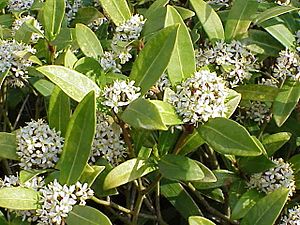Rutaceae facts for kids
Quick facts for kids Rutaceae |
|
|---|---|
 |
|
| Skimmia reevesiana | |
| Scientific classification | |
| Kingdom: | |
| Division: | |
| Class: | |
| Order: | |
| Family: |
Rutaceae
Juss., 1789
|
| Genera | |
|
About 160, totaling over 1600 species. |
|
The Rutaceae are a big family of flowering plants. You might know them better as the rue family or, more commonly, the citrus family. These plants are usually grouped into the order called Sapindales.
Plants in the Rutaceae family often have flowers with four or five parts. Many of them also have a very strong, pleasant smell. They come in all shapes and sizes, from small herbs to shrubs and even large trees.
Contents
What Are Rutaceae Plants?
The Rutaceae family is a group of plants that share many features. They are known for their special oil glands, which give them their strong scents. These glands are found in their leaves, flowers, and fruit peels. Think about the smell when you peel an orange or a lemon – that's the oils from these glands!
Where Do Rutaceae Plants Grow?
You can find members of the Rutaceae family all over the world, especially in warm, tropical, and temperate areas. Many citrus fruits, for example, grow best in sunny places with mild winters. Some types, like the rue plant, can also grow in cooler climates.
Common Examples of Rutaceae
The most famous members of this family are the citrus fruits. These include:
- Oranges
- Lemons
- Limes
- Grapefruits
- Mandarins
But the family is much bigger than just citrus! Other interesting plants in this group include:
- The rue plant, which is an herb.
- The Skimmia plant, often grown in gardens.
- The Cork-tree, which is a type of tree.
Characteristics of Rutaceae Plants
Plants in the Rutaceae family have several unique features that help scientists identify them.
Leaves and Stems
Most Rutaceae plants have leaves that are divided into smaller leaflets, or they might have simple leaves. These leaves often have tiny, clear dots that you can see if you hold them up to the light. These dots are the oil glands! The stems can be woody, like in trees and shrubs, or soft, like in herbs.
Flowers and Reproduction
The flowers of Rutaceae plants are usually quite pretty and often have a strong, sweet smell. This smell helps to attract pollinators like bees and butterflies.
- Their flowers typically have four or five petals and sepals.
- They also have a specific number of stamens (the parts that produce pollen).
- After pollination, the flowers develop into fruits.
Fruits of the Rutaceae Family
The fruits of Rutaceae plants are very diverse. Citrus fruits, for example, are a special type of berry called a hesperidium. This type of fruit has a tough, leathery rind (peel) and juicy segments inside. Other plants in the family might have different kinds of fruits, like capsules or drupes.
Uses of Rutaceae Plants
The Rutaceae family is very important to humans for many reasons.
Food and Drinks
Citrus fruits are a huge part of our diet. They are packed with Vitamin C and are used in countless dishes, juices, and desserts around the world. From fresh oranges to lemonades and lime pies, these fruits are delicious and healthy.
Essential Oils and Perfumes
Because of their strong scents, many Rutaceae plants are used to make essential oils. These oils are used in perfumes, soaps, and even for aromatherapy. The oil from orange peels, for example, is widely used.
Medicinal Uses
Some plants in the Rutaceae family have been used in traditional medicine for a long time. For example, the rue plant has been used for various purposes, though it's important to be careful with medicinal plants.
Ornamental Plants
Many Rutaceae plants are grown in gardens and parks because they are beautiful. Their attractive flowers, shiny leaves, and sometimes colorful fruits make them popular choices for landscaping.
Images for kids
See also
 In Spanish: Rutáceas para niños
In Spanish: Rutáceas para niños


